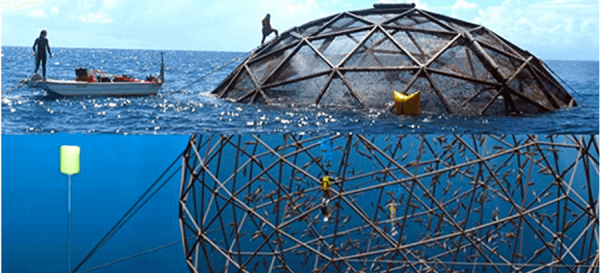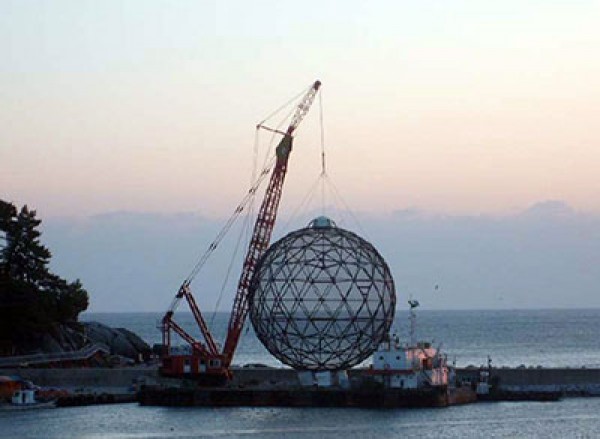Until recently, only a fraction of the world’s calories originated in farmed fish, but today it’s increasingly common. Aquaculture is an industry on the rise, and it’s increasingly a process that has more in common with your average agribusiness feedlot than it does with life in the great outdoors. Cages tethered to the shoreline can incur injuries to both fish and fish-farmers alike, and near-shore cages can collect waste on the sea floor, creating conditions ripe for disease. Which is to say, today’s aquaculture is often as polluting as it is inhumane.
Steve Page, the president of Ocean Farm Technologies, wants to change all that. His Aquapod Net Pen is a far cry from the kind of offshore fish-feedlots that resemble submerged trampolines. They are, rather, an environment that gives fish some room to move in the open ocean, via one of the world’s great design innovations: the geodesic dome.

Page gained experience with Buckminster Fuller’s dome design in the 1960s, when he helped to build a geodesic dome in California. Eventually, he went to work with companies that were raising Atlantic salmon in fish farms on the East Coast. According to Fast Company, it wasn’t just hearing complaints about the sight of floating cages that bothered him, it was the injuries he witnessed, to both human and fish, that arose in the course of pulling those heavy nets out on the water. He knew if the future of aquaculture called for moving farther away from land, the handling of these stationary nets was going to become an even bigger issue, due to rougher waters. So he decided to pioneer a more sustainable solution.
Page’s Aquapod containment system for marine aquaculture is unique in that it’s constructed of individual triangle net panels fastened together in a spheroid shape. Suitable for open ocean farming, these net panels are reinforced high density polyethylene with 80 percent recycled content that are covered with a coated galvanized steel wire mesh netting. Individual net panels or groups of panels can be modified to accommodate access, feeding, fish transfer, grading, and harvesting. The Aquapod functions as a secure containment system for finish while submerged or partially surfaced — a design innovation that allows for sustainable aquaculture systems in the open ocean.

Page installed his first Aquapod in 2005 in New Hampshire, and has since gone on to construct 34 spheres around the world. His company has now merged with Earth Ocean Farms in Mexico and is working together on a commercial shrimp and fish installation.
According to PBS’s Newshour, eating more farmed fish could be an ecological boon worldwide, as fish are significantly more efficient than other animals at converting feed into plate-ready protein. A cleaner, more humane way to make that happen is, clearly, a boon to both fish and the environment as a whole. But Page says his cages may actually support a broader resurgence of marine life. “We’re taking basically ocean floor that’s a desert and introducing habitat,” he told Fast Company. “We’ve found that Aquapods become fish attraction devices in themselves. It’s amazing the diversity of species that begins to colonize the whole water column around the Aquapods.”
Interested in more aquaculture solutions involving the geodesic dome? Check out our post on The Globe rooftop greenhouse design.